Layman D. Biology Demystified: A Self-Teaching Guide
Подождите немного. Документ загружается.


nal environment. Insects are important biological inducers (in-DEW-surs) –
‘‘leaders into’’ various states of environmental change.
BUSY POLLINATORS OF FLOWERS
Various insects visit flowers to feed upon their nectar (NEK-tar). Nectar is
named for the ‘‘drink of the gods’’ in Greek and Roman mythology. The
connection is probably the fact that nectar is sweet and filled with highly
nutritious plant sugars. And busy bees gather this sweet nectar and transform
it into an even-sweeter honey. Bees and butterflies visit flowers and feed on
their nectar during the day, while moths show up at night.
During day-or-night visitations, these insects help induce pollination. You
may recall (Chapter 9) that pollination is the process of spreading pollen
grains from male plants to female plants, so the females can be fertilized.
Without insect-induced pollination, many green plants would eventually
die, and with it, most photosynthesis occurring on the Earth. Therefore,
insect-induced pollination of flowering plants is a critical factor in the Web
of Life.
THE MENACING SWARMS
Just as some insects are busy inducers of pollination and promoters of
Biological Order, others attack human crops in menacing swarms.A
swarm is a large group of related insects that fly or move together.
Communication among insects in the swarm may be highly orderly and
efficient, allowing the huge group to carry out important tasks. A swarm
of bees, for instance, may move as a group of thousands from a damaged
hive to a safer area, and build another hive. The new geographic area with
the hive will benefit from an increased pollination of its flowers.
But a swarm of locusts (LOW-kusts) is quite another matter! A locust is a
type of grasshopper with short antennae. Due to their amazing powers of
rapid reproduction, swarms of locusts can darken the sky as they fly.
Wherever they land as a group of billions, whole tracts of fields and forests
are quickly stripped of their leaves. The entire ecosystem in a particular area
can be effectively destroyed, depriving the region of the benefits of life-giving
photosynthesis. Since the days of Ancient Egypt, farmers have been faced
with the difficult task of repairing the devastation of Biological Disorder
wreaked by insect swarms.
CHAPTER 11 The Arthropods 187
[13:25 13/6/03 N:/4058 LAYMAN.751/4058-Alltext.3d] Ref: 4058 Layman: Biology Demystified All-text Page: 187 1-388
5, Web
1, B-Web

Quiz
Refer to the text in this chapter if necessary. A good score is at least 8 correct
answers out of these 10 questions. The answers are found in the back of this
book.
1. The arthropods are distinguished from other invertebrates by their:
(a) Lack of jointed backbones
(b) Presence of distinctly jointed legs and feet
(c) Ability to reproduce asexually
(d) Tendency to crawl slowly over the ground
2. By referring to the cephalothorax, it is meant that:
(a) The arthropod body is thoroughly segmented
(b) Invertebrates lack brain tissue
(c) All external attachments or appendages are absent
(d) The head and chest segments have been lumped together
3. The lobster can just keep growing bigger and bigger, for as long as it
lives! ‘‘So,’’ you may well ask, ‘‘why doesn’t the lobster rip its own
skin?’’
(a) The lobster doesn’t have any covering or skin!
(b) There is an intermittent period of molting
(c) The lobster body does rip out of its skin, and then it quickly dies
(d) A rapid healing process takes place
4. The trilobites are most accurately described as:
(a) Primitive, insect-like creatures having two body segments
(b) Arthropods without jointed legs
(c) A long-extinct ancestor of the modern crustaceans
(d) A vanished group of extremely overdeveloped mollusks
5. As a group, the arachnids:
(a) Consist solely of spiders and their webs
(b) Include practically all types of insects
(c) Generally have bodies with eight or more segments
(d) Involve scorpions, ticks, mites, and spiders
6. As a group, insects:
(a) Have bodies literally ‘‘cut into’’ three major segments
(b) Use eight hollow legs to move around
(c) Enjoy extremely long life spans, but infrequent reproduction
(d) Fly with at least 5 pairs of wings
[13:25 13/6/03 N:/4058 LAYMAN.751/4058-Alltext.3d] Ref: 4058 Layman: Biology Demystified All-text Page: 188 1-388
PART 3 Five Kingdoms of Life, plus Viruses
188

7. Metamorphosis:
(a) Generally involves the shrinkage of an adult back into a larva
(b) Is a mechanism for fluid transport (similar to diffusion)
(c) Always proceeds from one body form to another
(d) Generally occurs without any need for differentiation
8. ‘‘Insects (not human beings) are the real monarchs of Planet Earth!’’
Evidence supporting this statement is the fact that:
(a) Insects have far more ‘‘natural intelligence’’ than people
(b) Insecticides often poison humans, as well as insects
(c) Monarchs are the prettiest butterflies in the world!
(d) There are far more species of insects than any other type of animal
9. Bees can be considered inducers of Biological Order in that:
(a) Pollination resulting from their feeding visits for nectar allows
complex patterns of plant life to grow and thrive
(b) They often live in highly aggressive colonies that fiercely attack
hive invaders
(c) Flying only during daylight, they do not disturb dark-loving species
(d) Their attractive yellow-and-black body pattern stimulates other
organisms to adopt colorful forms of their own
10. Swarms of insects:
(a) Always attack and destroy whatever lies in their path
(b) Only occur in far northerly regions of the planet
(c) May involve highly orderly and efficient patterns of
communication and coordination
(d) Show no interactions among their members, whatsoever
The Giraffe ORDER TABLE for Chapter 11
(Key Text Facts About Biological Order Within An Organism)
1. ____________________________________________________________
2. ____________________________________________________________
CHAPTER 11 The Arthropods 189
[13:25 13/6/03 N:/4058 LAYMAN.751/4058-Alltext.3d] Ref: 4058 Layman: Biology Demystified All-text Page: 189 1-388
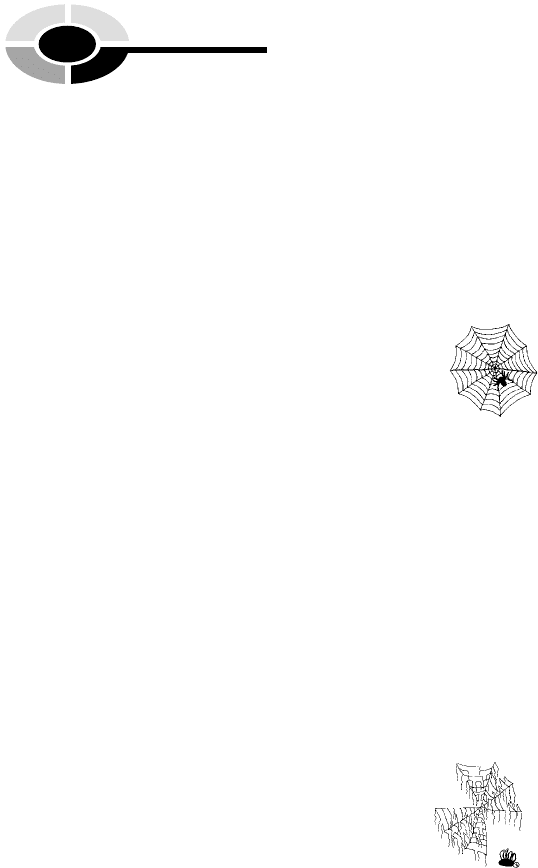
3. ____________________________________________________________
4. ____________________________________________________________
The Spider Web ORDER TABLE for Chapter 11
(Key Text Facts About Biological Order Beyond The Individual
Organism)
1. ____________________________________________________________
2. ____________________________________________________________
3. ____________________________________________________________
4. ____________________________________________________________
5. ____________________________________________________________
The Broken Spider Web DISORDER TABLE for Chapter 11
(Key Text Facts About Biological Disorder Beyond The Individual
Organism)
1. ____________________________________________________________
[13:25 13/6/03 N:/4058 LAYMAN.751/4058-Alltext.3d] Ref: 4058 Layman: Biology Demystified All-text Page: 190 1-388
PART 3 Five Kingdoms of Life, plus Viruses
190
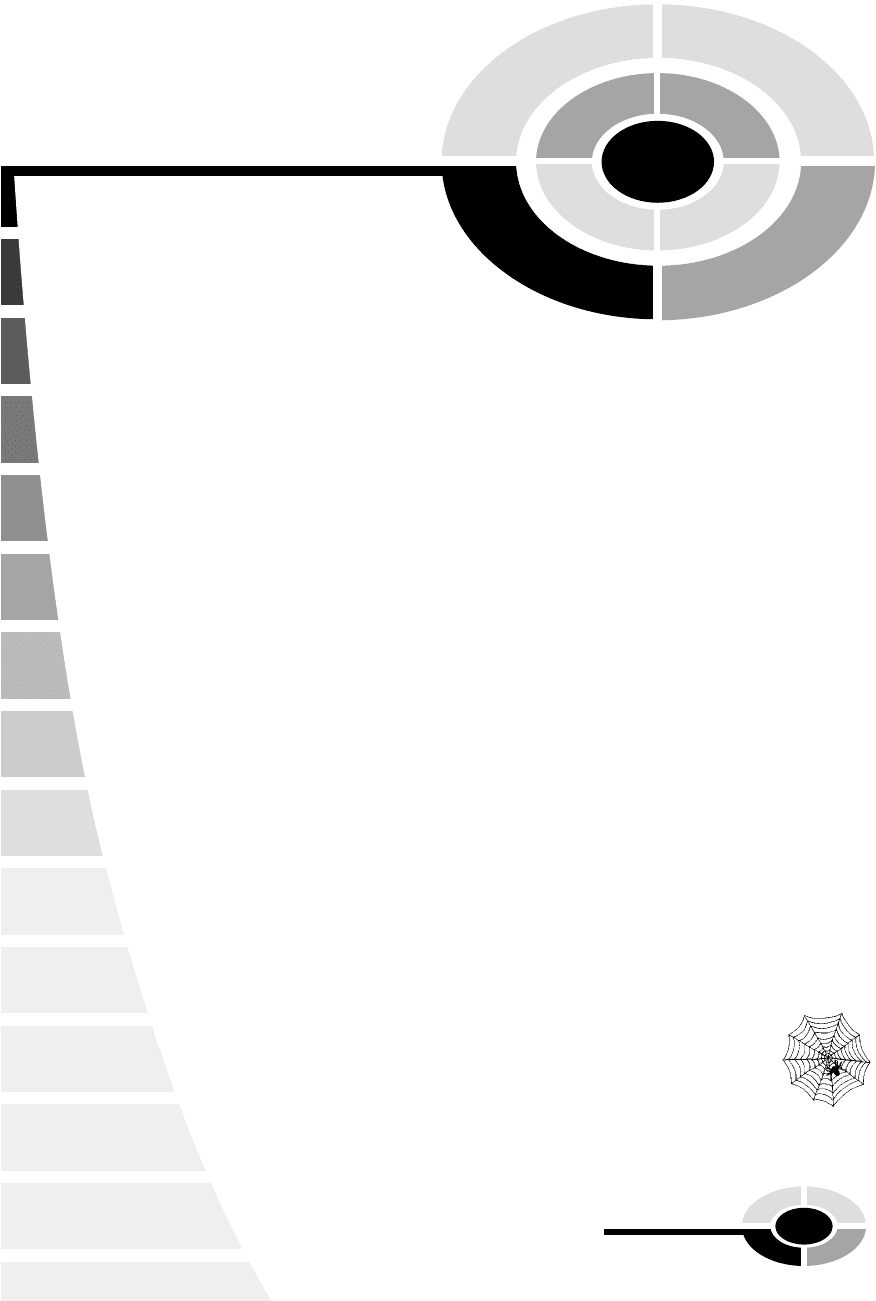
[13:25 13/6/03 N:/4058 LAYMAN.751/4058-Alltext.3d] Ref: 4058 Layman: Biology Demystified All-text Page: 191 1-388
191
CHAPTER
12
The Chordata:
Animals with a
‘‘Chord’’ in Their
‘‘Back’’
In the last two chapters (10 and 11), we were discussing the invertebrates. By
definition, these are animals without any linked bones (called vertebrae)
within their backs. You may remember (Chapter 3) that jellyfish, corals,
sea worms, and other multicellular invertebrates were probably among the
first animals to appear during evolution. Only within the last 500 million
years or so have there been any chordates (KOR-dates) – animals with
some kind of ‘‘chord’’ or ‘‘cord’’ present to stiffen their backs. It is this
later group, called the Phylum Chordata (kor-DAY-tuh), to which we now
turn with interest.
1, Web
Copyright 2003 by The McGraw-Hill Companies, Inc. Click Here for Terms of Use.
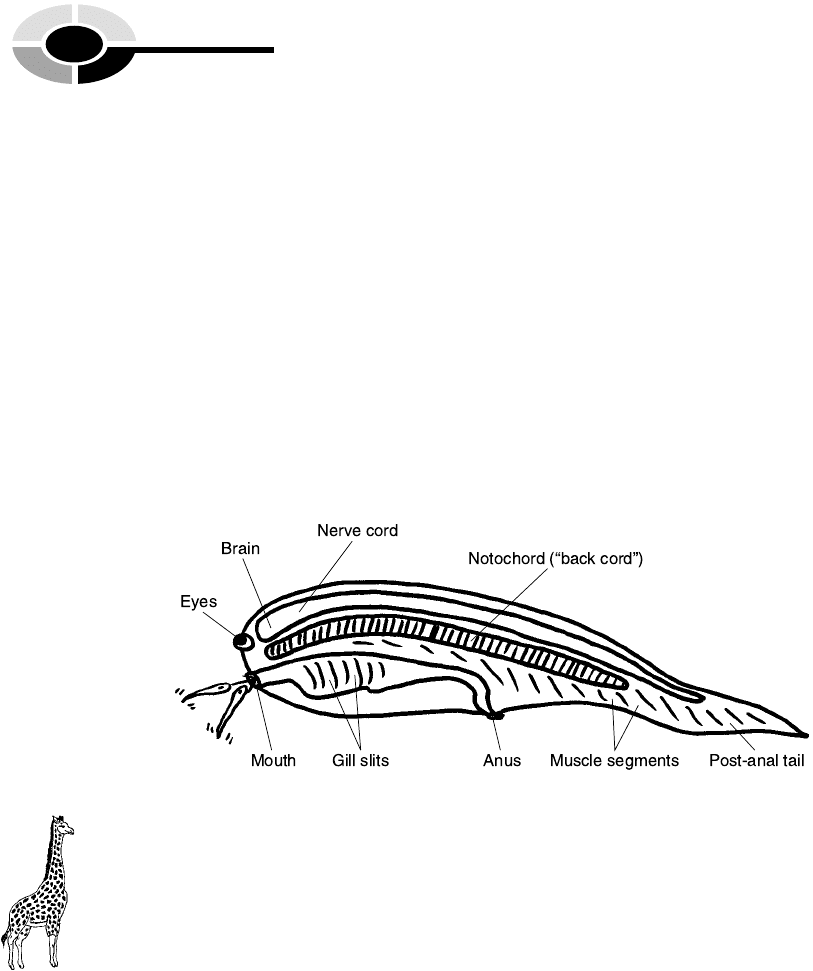
The Notochord: Ancient Forerunner of the
Vertebral Column
It is very reasonable for you, the reader, to ask, ‘‘Just what is meant by
having a chord or cord in your back?’’ This concept is best explained by
looking at Figure 12.1, which provides the general body plan of a primitive
chordate. This figure shows the four general characteristics of all chordates:
1. The presence of a slender notochord (NO-tuh-kord) running down the
back during at least part of the life cycle;
2. A hollow nerve cord that lies immediately dorsal to the notochord;
3. Gill slits along each side of the head; and
4. A post-anal (AY-nul) tail that is very muscular.
The notochord is the key anatomic feature. It is a long, narrow structure in
the ‘‘back’’ (noto-) that looks like a thin ‘‘cord’’ (chord) or rod. The noto-
chord’s chief function is supporting and stiffening the body. All chordates
have a notochord in their bodies during at least one stage of their develop-
ment. And it is this notochord that can serve as the basis for development of
a full vertebral column or ‘‘jointed backbone.’’
The Phylum Chordata and Its Groups
The Phylum Chordata can be subdivided into a number of different groups.
The major classifying factor is the answer to the following question: ‘‘Does
the particular chordate species being considered keep a notochord in its back
[13:25 13/6/03 N:/4058 LAYMAN.751/4058-Alltext.3d] Ref: 4058 Layman: Biology Demystified All-text Page: 192 1-388
PART 3 Five Kingdoms of Life, plus Viruses
192
Fig. 12.1 The general body plan of a primitive chordate.
1, Order
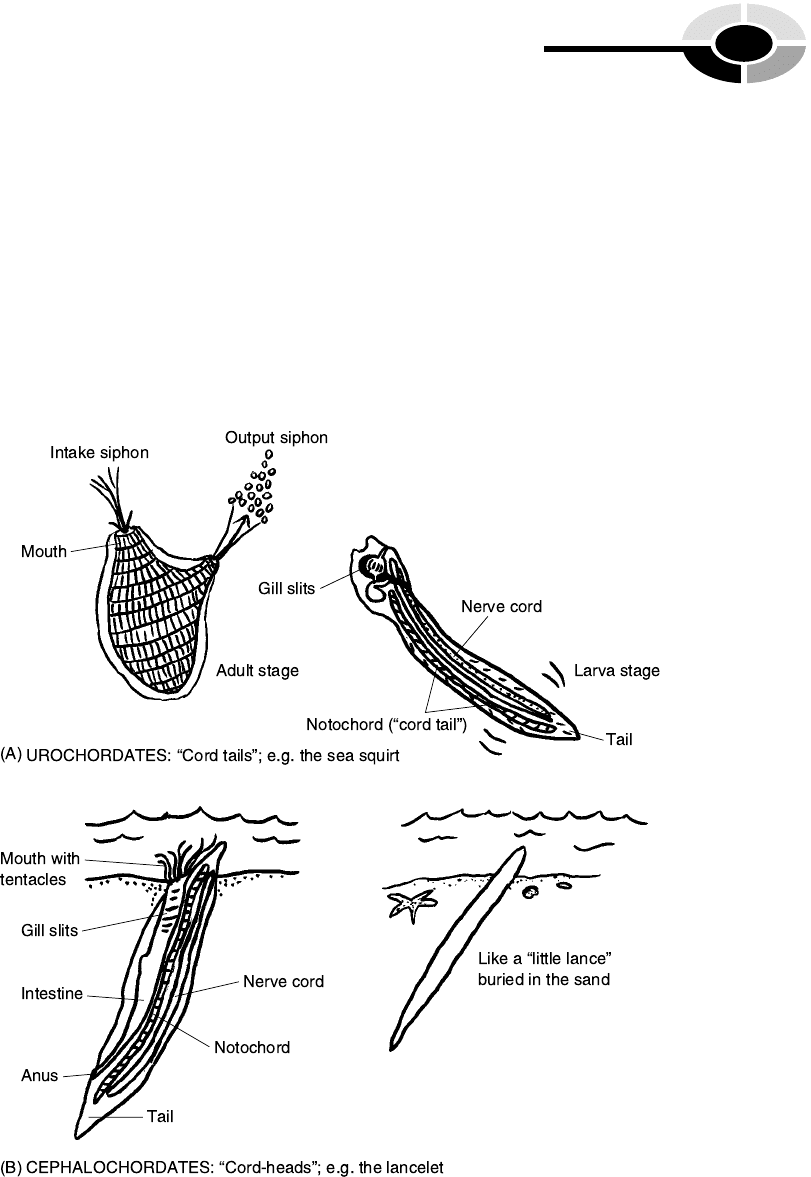
throughout its lifetime, or does it replace the notochord with a full vertebral
column after it has passed through the embryo stage?’’
THE SEA SQUIRTS AND LANCELETS: NO ‘‘JOINTED
BACKBONE’’
Figure 12.2 reveals that two of the major groups of chordates keep a noto-
chord in their back throughout their lives. These two groups are called the
Urochordates (YOUR-oh-kor-dates) and the Cephalochordates (SEF-uh-low-
kor-dates).
CHAPTER 12 The Chordata 193
[13:25 13/6/03 N:/4058 LAYMAN.751/4058-Alltext.3d] Ref: 4058 Layman: Biology Demystified All-text Page: 193 1-388
Fig. 12.2 Sea squirts and lancelets: Chordates without spines.

The Urochordates are animals that literally have a ‘‘cord’’ (chord) within
their ‘‘tail’’ (uro-). By this it is meant that these creatures have a swimming
larval stage with a notochord in its tail section. The main examples of
Urochordates are the sea squirts. Interestingly enough, the adult stage of
the sea squirt has a body shaped like a ‘‘U,’’ and it remains anchored to a
rock at the bottom of the sea. At one end lies an intake siphon, which sucks in
seawater and filters out plankton and other tiny creatures during feeding.
And at the other end lies an output siphon, which squirts or shoots out a jet of
water whenever the animal is bothered by a predator.
The Cephalochordates are literally a group of ‘‘cord-heads’’ (cephalo-)!
The implication of this odd name is displayed in Figure 12.2 (B) for the
lancelets (LANS-lits). The lancelets are slender, fish-like marine animals
that lie partially buried in the sand under shallow water. Their thin, tapered
body is pointed at both ends, making it look much like a small spear or ‘‘little
lance.’’ Because it has no skull, the lancelet doesn’t have a brain, either! Thus,
the notochord extends all the way up into its head, officially making it a
‘‘cord-head’’ (Cephalochordate). The lancelet is a type of suspension feeder,
meaning that it feeds on small particles suspended in seawater, which it draws
into its mouth with the help of waving, hair-like tentacles (TEN-tuh-kuls).
Both sea squirts and lancelets have notochords in their backs during at
least part of their life cycles, but they are still officially invertebrates. Many
biologists think that they are important evolutionary ‘‘bridging species’’
between the other invertebrates (which don’t even have a notochord) and
the true vertebrates (whose primitive notochord has been replaced by a
bony vertebral column).
THE VERTEBRATES – CHORDATES WITH A ‘‘JOINTED
BACKBONE’’
In contrast to the Urochordates and Cephalochordates, the Vertebrata (ver-
teh-BRA-tuh) or vertebrates are chordates with both a jointed (segmented)
backbone and a brain case or cranium (KRAY-nee-um) (see Figure 12.3). You
may recall (Chapter 11) that the ‘‘jointed backbones’’ are technically called
the vertebrae. The cranium is just a formal name for the ‘‘skull’’ (crani)
‘‘present’’ (-um) at the top of the vertebral column. Owing to their high
degree of cephalization (concentration of sensory, motor, and other nerve
functions within the head region), vertebrates have a brain in their cranium.
The vertebrates generally have a notochord only as part of their embryonic
stage of development. As their bodies mature, the notochord is replaced by a
vertebral column (linked series of jointed vertebrae).
[13:25 13/6/03 N:/4058 LAYMAN.751/4058-Alltext.3d] Ref: 4058 Layman: Biology Demystified All-text Page: 194 1-388
2, Web
3, Web
PART 3 Five Kingdoms of Life, plus Viruses
194
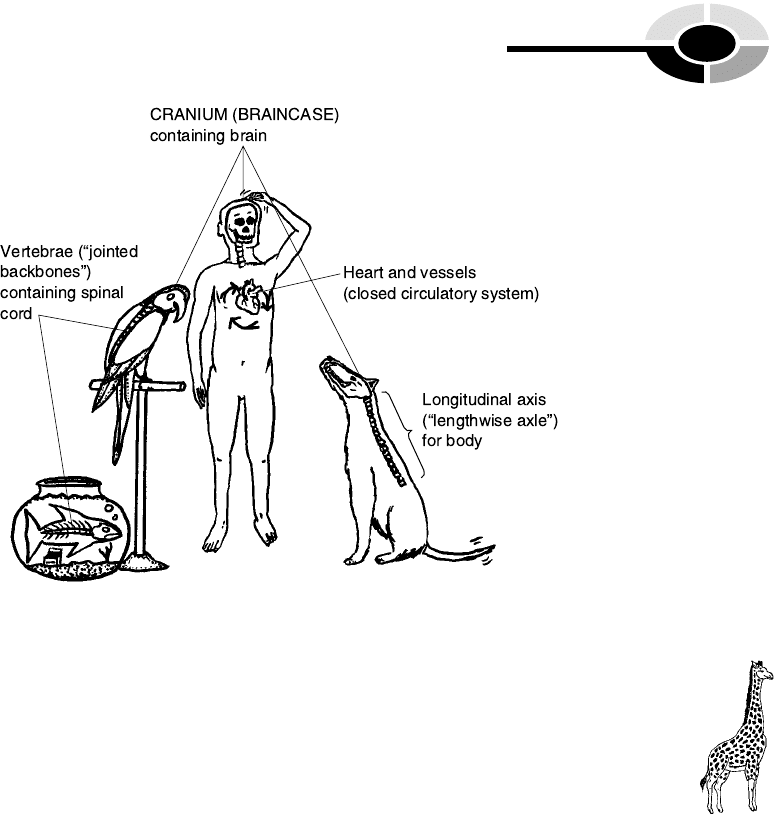
The dorsal nerve cord, now protected by a vertebral column, is called the
spinal cord. The skull (brain case or cranium), vertebral column, and ribs
make up what is called the axial (AX-ee-ul) skeleton. The reason for this
name is the pattern set by the bones or cartilage (KAR-tih-lj), commonly
known as ‘‘gristle,’’ which house the brain and spinal cord. This ordered
bone/cartilage pattern forms a longitudinal (long-jih-TWO-duh-nal) axis,or
‘‘lengthwise axle,’’ around which the vertebrate body can turn or pivot.
Finally, vertebrates have a closed circulatory system. The heart serves as a
pump, which sends the blood coursing out through the entire body. After the
body tissues are supplied with oxygen, glucose, and other nutrients, the blood
(now filled with tissue waste products) returns back to the heart through a
closed loop of vessels.
Wide Diversity in Backboned Creatures: Eight
Different Classes of Vertebrates
Although all vertebrates share a common core of characteristics, they still
show a very wide degree of diversity or differences among them. This diver-
CHAPTER 12 The Chordata 195
[13:25 13/6/03 N:/4058 LAYMAN.751/4058-Alltext.3d] Ref: 4058 Layman: Biology Demystified All-text Page: 195 1-388
Fig. 12.3 Basic elements of the vertebrate body.
2, Order

sity is reflected in the existence of eight different classes of vertebrates. These
are named the Class Agnatha (AG-nuh-thuh), Class Placodermi (PLAK-uh-
derm-ee), Class Chondrichthyes (kahn-DRIK-thees), Class Osteichthyes (ahs-
tee-IK-thee-eez), Class Amphibia (am-FIB-ee-ah), Class Reptilia (rep-TIL-ee-
ah), Class Aves (AY-veez), and Class Mammalia (mah-MAY-lee-uh). [Study
suggestion: The eight different vertebrate classes are each labeled with brief
representative pictures in Figure 12.4. Before reading any farther in this
chapter, see if you can match each of the pictures with the appropriate
English translations of their Class names, as follows: the Class of ‘‘birds;’’
the Class of ‘‘cartilage-fishes;’’ the Class of ‘‘livers of a double life {on both
the land and in the water};’’ the Class of ‘‘jawless’’ fishes; the Class of animals
[13:25 13/6/03 N:/4058 LAYMAN.751/4058-Alltext.3d] Ref: 4058 Layman: Biology Demystified All-text Page: 196 1-388
PART 3 Five Kingdoms of Life, plus Viruses
196
Fig. 12.4 The eight major classes of vertebrates.
